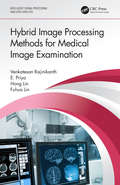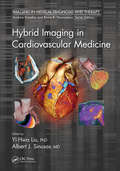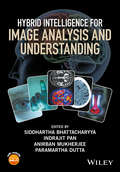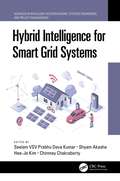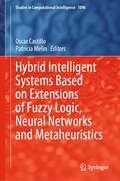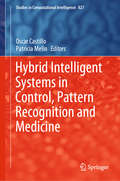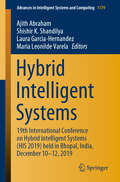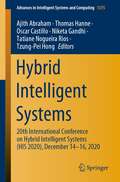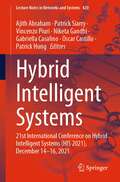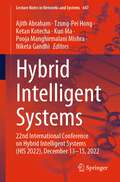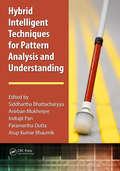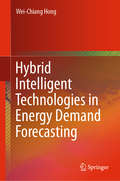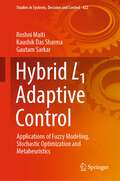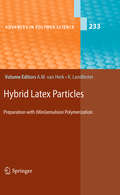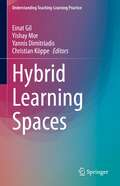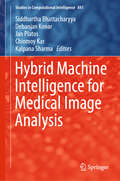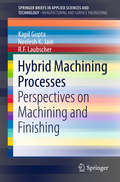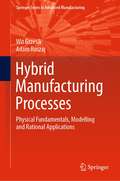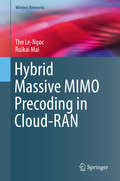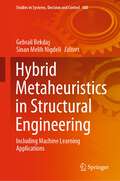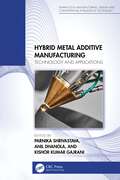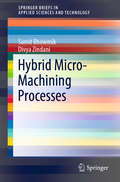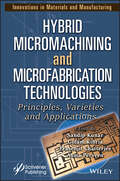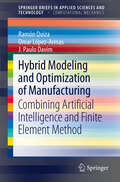- Table View
- List View
Hybrid Image Processing Methods for Medical Image Examination (Intelligent Signal Processing and Data Analysis)
by Hong Lin Venkatesan Rajinikanth E Priya Fuhua LinIn view of better results expected from examination of medical datasets (images) with hybrid (integration of thresholding and segmentation) image processing methods, this work focuses on implementation of possible hybrid image examination techniques for medical images. It describes various image thresholding and segmentation methods which are essential for the development of such a hybrid processing tool. Further, this book presents the essential details, such as test image preparation, implementation of a chosen thresholding operation, evaluation of threshold image, and implementation of segmentation procedure and its evaluation, supported by pertinent case studies. Aimed at researchers/graduate students in the medical image processing domain, image processing, and computer engineering, this book: Provides broad background on various image thresholding and segmentation techniques Discusses information on various assessment metrics and the confusion matrix Proposes integration of the thresholding technique with the bio-inspired algorithms Explores case studies including MRI, CT, dermoscopy, and ultrasound images Includes separate chapters on machine learning and deep learning for medical image processing
Hybrid Imaging in Cardiovascular Medicine (Imaging in Medical Diagnosis and Therapy)
by Yi-Hwa Liu Albert J. SinusasThis comprehensive book focuses on multimodality imaging technology, including overviews of the instruments and methods followed by practical case studies that highlight use in the detection and treatment of cardiovascular diseases. Chapters cover PET-CT, SPECT-CT, SPECT-MRI, PET-MRI, PET-optical imaging, SPECT-optical imaging, photoacoustic Imaging, and hybrid intravascular imaging. It also addresses the important issues of multimodality imaging probes and image quantification. <P><P>Readers from radiology and cardiology as well as medical imaging and biomedical engineering will learn essentials of the field. They will be shown how the field has advanced quantitative analysis of molecularly targeted imaging through improvements in the reliability and reproducibility of imaging data. Moreover, they will be presented with quantification algorithms and case illustrations, including coverage of such topics such as multimodality image fusion and kinetic modeling. <P><P>Yi-Hwa Liu, PhD is Senior Research Scientist in Cardiovascular Medicine at Yale University School of Medicine and Technical Director of Nuclear Cardiology at Yale New Haven Hospital. He is also an Associate Professor (Adjunct) of Biomedical Imaging and Radiological Sciences at National Yang-Ming University, Taipei, Taiwan, and Professor (Adjunct) of Biomedical Engineering at Chung Yuan Christian University, Taoyuan, Taiwan. He is an elected senior member of Institute of Electrical and Electronic Engineers (IEEE) and a full member of Sigma Xi of The Scientific Research Society of North America. <P><P>Albert J. Sinusas, M.D., FACC, FAHA is Professor of Medicine (Section of Cardiovascular Medicine) and Radiology and Biomedical Imaging, at Yale University School of Medicine, and Director of the Yale Translational Research Imaging Center (Y-TRIC), and Director of Advanced Cardiovascular Imaging at Yale New Haven Hospital. He is a recipient of the Society of Nuclear Medicine’s Hermann Blumgart Award.
Hybrid Intelligence for Image Analysis and Understanding
by Siddhartha Bhattacharyya Paramartha Dutta Anirban Mukherjee Indrajit PanA synergy of techniques on hybrid intelligence for real-life image analysis Hybrid Intelligence for Image Analysis and Understanding brings together research on the latest results and progress in the development of hybrid intelligent techniques for faithful image analysis and understanding. As such, the focus is on the methods of computational intelligence, with an emphasis on hybrid intelligent methods applied to image analysis and understanding. The book offers a diverse range of hybrid intelligence techniques under the umbrellas of image thresholding, image segmentation, image analysis and video analysis. Key features: Provides in-depth analysis of hybrid intelligent paradigms. Divided into self-contained chapters. Provides ample case studies, illustrations and photographs of real-life examples to illustrate findings and applications of different hybrid intelligent paradigms. Offers new solutions to recent problems in computer science, specifically in the application of hybrid intelligent techniques for image analysis and understanding, using well-known contemporary algorithms. The book is essential reading for lecturers, researchers and graduate students in electrical engineering and computer science.
Hybrid Intelligence for Smart Grid Systems (Advances in Intelligent Decision-Making, Systems Engineering, and Project Management)
by Seelam VSV Prabhu Deva KumarThis book provides an overview of distributed control and distributed optimization theory, followed by specific details on industrial applications to smart grid systems. It discusses the fundamental analysis and design schemes for developing actual working smart grids and covers all aspects concerning the conventional and nonconventional methods of their use. Hybrid Intelligence for Smart Grid Systems provides an overview of a smart grid, along with its needs, benefits, challenges, and existing structure and describes the inverter topologies adopted for integrating renewable power, and provides an overview of its needs, benefits, challenges, and possible future technologies. This pioneering book is a must-read for researchers, engineering professionals, and students, giving them the tools needed to move from the concept of a smart grid to its actual design and implementation. Moreover, it will enable regulators, policymakers, and energy executives to understand the future of energy delivery systems towards safe, economical, high-quality power delivery in a dynamic and demanding environment.
Hybrid Intelligence: Proceedings of the 4th International Conference on Computational Design and Robotic Fabrication (CDRF 2022) (Computational Design and Robotic Fabrication)
by Philip F. Yuan Chao Yan Hua Chai Keke Li Tongyue SunThis open access book is a compilation of selected papers from DigitalFUTURES 2022—The 4th International Conference on Computational Design and Robotic Fabrication (CDRF 2022). The work focuses on novel techniques for computational design and robotic fabrication. The contents make valuable contributions to academic researchers, designers, and engineers in the industry. As well, readers encounter new ideas about intelligence in architecture.
Hybrid Intelligent Systems Based on Extensions of Fuzzy Logic, Neural Networks and Metaheuristics (Studies in Computational Intelligence #1096)
by Oscar Castillo Patricia MelinIn this book, recent theoretical developments on fuzzy logic, neural networks and optimization algorithms, as well as their hybrid combinations, are presented. In addition, the above-mentioned methods are presented in application areas such as, intelligent control and robotics, pattern recognition, medical diagnosis, decision-making, time series prediction and optimization of complex problems. The book contains a collection of papers focused on hybrid intelligent systems based on soft computing techniques. There are a group of papers with the main theme of type-1 and type-2 fuzzy logic, which basically consists of papers that propose new concepts and algorithms based on type-1 and type-2 fuzzy logic and their applications. There also a group of papers that offer theoretical concepts and applications of meta-heuristics in different areas. Another group of papers outlines diverse applications of fuzzy logic, neural networks and hybrid intelligent systems in medical problems. There are also some papers that present theory and practice of neural networks in different application areas. In addition, there are papers that offer theory and practice of optimization and evolutionary algorithms in different application areas. Finally, there are a group of papers describing applications of fuzzy logic, neural networks and meta-heuristics in pattern recognition and classification problems.
Hybrid Intelligent Systems in Control, Pattern Recognition and Medicine (Studies in Computational Intelligence #827)
by Oscar Castillo Patricia MelinThis book describes the latest advances in fuzzy logic, neural networks and optimization algorithms, as well as their hybrid combinations, and their applications in areas such as: intelligent control and robotics, pattern recognition, medical diagnosis, time series prediction, and optimization of complex problems. The book is divided into five main parts. The first part proposes new concepts and algorithms based on type-1 and type-2 fuzzy logic and their applications; the second explores new concepts and algorithms in neural networks and fuzzy logic applied to recognition. The third part examines the theory and practice of meta-heuristics in various areas of application, while the fourth highlights diverse applications of fuzzy logic, neural networks and hybrid intelligent systems in medical contexts. Finally, the fifth part focuses on applications of fuzzy logic, neural networks and meta-heuristics to robotics problems.
Hybrid Intelligent Systems: 19th International Conference on Hybrid Intelligent Systems (HIS 2019) held in Bhopal, India, December 10-12, 2019 (Advances in Intelligent Systems and Computing #1179)
by Ajith Abraham Maria Leonilde Varela Shishir K. Shandilya Laura Garcia-HernandezThis book highlights the recent research on hybrid intelligent systems and their various practical applications. It presents 34 selected papers from the 18th International Conference on Hybrid Intelligent Systems (HIS 2019) and 9 papers from the 15th International Conference on Information Assurance and Security (IAS 2019), which was held at VIT Bhopal University, India, from December 10 to 12, 2019. A premier conference in the field of artificial intelligence, HIS - IAS 2019 brought together researchers, engineers and practitioners whose work involves intelligent systems, network security and their applications in industry. Including contributions by authors from 20 countries, the book offers a valuable reference guide for all researchers, students and practitioners in the fields of Computer Science and Engineering.
Hybrid Intelligent Systems: 20th International Conference on Hybrid Intelligent Systems (HIS 2020), December 14-16, 2020 (Advances in Intelligent Systems and Computing #1375)
by Ajith Abraham Oscar Castillo Thomas Hanne Tzung-Pei Hong Niketa Gandhi Tatiane Nogueira RiosThis book highlights the recent research on hybrid intelligent systems and their various practical applications. It presents 58 selected papers from the 20th International Conference on Hybrid Intelligent Systems (HIS 2020) and 20 papers from the 12th World Congress on Nature and Biologically Inspired Computing (NaBIC 2020), which was held online, from December 14 to 16, 2020. A premier conference in the field of artificial intelligence, HIS - NaBIC 2020 brought together researchers, engineers and practitioners whose work involves intelligent systems, network security and their applications in industry. Including contributions by authors from 25 countries, the book offers a valuable reference guide for all researchers, students and practitioners in the fields of science and engineering.
Hybrid Intelligent Systems: 21st International Conference on Hybrid Intelligent Systems (HIS 2021), December 14–16, 2021 (Lecture Notes in Networks and Systems #420)
by Ajith Abraham Oscar Castillo Vincenzo Piuri Patrick Siarry Niketa Gandhi Gabriella Casalino Patrick HungThis book highlights the recent research on hybrid intelligent systems and their various practical applications. It presents 45 selected papers from the 20th International Conference on Hybrid Intelligent Systems (HIS 2021) and 16 papers from the 17th International Conference on Information Assurance and Security, which was held online, from December 14 to 16, 2021. A premier conference in the field of artificial intelligence and machine learning applications, HIS-IAS 2021 brought together researchers, engineers and practitioners whose work involves intelligent systems, network security and their applications in industry. Including contributions by authors from over 20 countries, the book offers a valuable reference guide for all researchers, students and practitioners in the fields of computer science and engineering.
Hybrid Intelligent Systems: 22nd International Conference on Hybrid Intelligent Systems (HIS 2022), December 13–15, 2022 (Lecture Notes in Networks and Systems #647)
by Ajith Abraham Tzung-Pei Hong Kun Ma Niketa Gandhi Ketan Kotecha Pooja Manghirmalani MishraThis book highlights the recent research on hybrid intelligent systems and their various practical applications. It presents 97 selected papers from the 22nd International Conference on Hybrid Intelligent Systems (HIS 2022) and 26 papers from the 18th International Conference on Information Assurance and Security, which was held online, from 13 to 15 December 2022. A premier conference in the field of artificial intelligence and machine learning applications, HIS–IAS 2022, brought together researchers, engineers and practitioners whose work involves intelligent systems, network security and their applications in industry. Including contributions by authors from over 35 countries, the book offers a valuable reference guide for all researchers, students and practitioners in the fields of Computer Science and Engineering.
Hybrid Intelligent Techniques for Pattern Analysis and Understanding
by Siddhartha Bhattacharyya Paramartha Dutta Anirban Mukherjee Indrajit Pan Arup Kumar BhaumikHybrid Intelligent Techniques for Pattern Analysis and Understanding outlines the latest research on the development and application of synergistic approaches to pattern analysis in real-world scenarios. An invaluable resource for lecturers, researchers, and graduates students in computer science and engineering, this book covers a diverse range of hybrid intelligent techniques, including image segmentation, character recognition, human behavioral analysis, hyperspectral data processing, and medical image analysis.
Hybrid Intelligent Technologies in Energy Demand Forecasting
by Wei-Chiang HongThis book is written for researchers and postgraduates who are interested in developing high-accurate energy demand forecasting models that outperform traditional models by hybridizing intelligent technologies. It covers meta-heuristic algorithms, chaotic mapping mechanism, quantum computing mechanism, recurrent mechanisms, phase space reconstruction, and recurrence plot theory. The book clearly illustrates how these intelligent technologies could be hybridized with those traditional forecasting models. This book provides many figures to deonstrate how these hybrid intelligent technologies are being applied to exceed the limitations of existing models.
Hybrid L1 Adaptive Control: Applications of Fuzzy Modeling, Stochastic Optimization and Metaheuristics (Studies in Systems, Decision and Control #422)
by Gautam Sarkar Roshni Maiti Kaushik Das SharmaThis book details the designing of hybrid control strategies for practical systems containing time varying uncertainties, disturbances, nonlinearities, unknown parameters, unmodelled dynamics, delays, etc., concurrently. In this book, the advantages of different controllers will be brought together to produce superior control performance for the practical systems. Being aware of the advantages of adaptive controller to tackle unknown constant, time varying uncertainties and time varying disturbances, a variant of adaptive controller, namely L1 adaptive controller, is hybridized with other strategies. In this book, to facilitate optimal parameter setting of the basic L1 adaptive controller, stochastic optimization technique will be hybridized with it. The stability of the optimization technique along with the controller will be guaranteed analytically with the help of spectral radius convergence. The proposed method exhibits satisfactory exploration and exploitation capabilities. Again, this book will throw light on tackling nonlinearities along with uncertainties and disturbances by hybridizing fuzzy logic with L1 adaptive controller. The performances of the designed controllers will be compared with different control methodologies to validate their effectiveness. The overall stability of the nonlinear system with the designed controller will be guaranteed with the help of fuzzy Lyapunov function to retain the zonal behaviour of the system. This fuzzy PDC-L1 adaptive controller is efficient to tackle nonlinearities and at the same time cancels unknown constant, time varying uncertainties and time varying disturbances adequately. This book will also contain four simulation case studies to validate fruitfulness of the designed controllers. To demonstrate the superior control ability of these controllers in tackling practical system, three experimental case studies will also be provided.
Hybrid Latex Particles
by Alex M. Herk Katharina LandfesterHistorical Overview of (Mini)emulsion Polymerizations and Preparation of Hybrid Latex Particles, by A.M. van Herk; * Physical Methods for the Preparation of Hybrid Nanocomposite Polymer Latex Particles, by R. F.A. Teixeira and S. A.F. Bon; * Organic/Inorganic Composite Latexes: The Marriage of Emulsion Polymerization and Inorganic Chemistry, by Elodie Bourgeat-Lami and Muriel Lansalot; * Preparation of Hybrid Latex Particles and Core-Shell Particles Through the Use of Controlled Radical Polymerization Techniques in Aqueous Media, by Bernadette Charleux, Franck D'Agosto, and Guillaume Delaittre; * Miniemulsion Polymerization as a Means to Encapsulate Organic and Inorganic Materials, by Clemens K.Weiss and Katharina Landfester; * Organic-Inorganic Hybrid Magnetic Latex, by Md Mahbubor Rahman and Abdelhamid Elaissari
Hybrid Learning Spaces (Understanding Teaching-Learning Practice)
by Yishay Mor Einat Gil Yannis Dimitriadis Christian KöppeAs we have come to accept the duality of physical and virtual learning spaces as a permanent feature of our educational landscape, we begin to question its validity. Is this really a dichotomy, or is it a continuum? Should this be the primary dimension around which we cluster educational experiences - how does it intersect and interact with other axes, such as formal-informal, vocational-recreational, open-closed, teacher-student? How do we adapt, as teachers, learners, designers, policy makers, to this changing landscape? How do we shape it to offer an optimal learning experience? Such questions led us to conduct a series of academic and professional events on the theme of Hybrid Learning Spaces (HLS) - spaces which challenge and defy the dichotomies above. This edited book collates some of the products of that endeavor, offering a multi-vocal, interdisciplinary approach to hybridity in education. It connects practical examples, design directives and theoretical analysis, combining perspectives from technology research and development, educational theory and practice, architecture and space and product design. This book addresses researchers, practitioners, innovators and policy makers in education, technology and design, offering broad perspectives and then distilling practical insights in the form of design principles and patterns, pedagogical models, and predictions of future trends.
Hybrid Machine Intelligence for Medical Image Analysis (Studies in Computational Intelligence #841)
by Kalpana Sharma Siddhartha Bhattacharyya Debanjan Konar Jan Platos Chinmoy KarThe book discusses the impact of machine learning and computational intelligent algorithms on medical image data processing, and introduces the latest trends in machine learning technologies and computational intelligence for intelligent medical image analysis. The topics covered include automated region of interest detection of magnetic resonance images based on center of gravity; brain tumor detection through low-level features detection; automatic MRI image segmentation for brain tumor detection using the multi-level sigmoid activation function; and computer-aided detection of mammographic lesions using convolutional neural networks.
Hybrid Machining Processes
by Kapil Gupta Neelesh K. Jain R. F. LaubscherThis book describes various hybrid machining and finishing processes. It gives a critical review of the past work based on them as well as the current trends and research directions. For each hybrid machining process presented, the authors list the method of material removal, machining system, process variables and applications. This book provides a deep understanding of the need, application and mechanism of hybrid machining processes.
Hybrid Manufacturing Processes: Physical Fundamentals, Modelling and Rational Applications (Springer Series in Advanced Manufacturing)
by Wit Grzesik Adam RuszajThis book explores, in a systematic way, both conventional and unconventional material shaping processes with various modes of hybridization in relation to theory, modelling and industrial potential. The demand for high productivity and high accuracy in manufacturing is continuously increasing, based on improvement and optimization strategies. Hybridization of manufacturing processes will play a crucial role and will be of a key importance in achieving environmental and economical sustainability.Structured in three parts, Hybrid Manufacturing Processes summarizes the state-of-the art hybrid manufacturing processes based on available literature sources and production reports. The book begins by providing information on the physical fundamentals of the removal and non-removal processes in macro-, micro and nanoscales. It then follows with an overview of the possible ways of hybridization and the effects on the enhancement of process performance, before concluding with a summary of production outputs related to surface integrity, specifically with respect to difficult-to-machine materials.Considering the applications of different sources of hybridization including mechanical, thermal and chemical interactions or their combinations, this book will be of interest to a range of researchers and practicing engineers within the field of manufacturing.
Hybrid Massive MIMO Precoding in Cloud-RAN (Wireless Networks)
by Tho Le-Ngoc Ruikai MaiThis book covers the design and optimization of hybrid RF-baseband precoding for massive multiple-input multiple-output (MIMO)-enabled cloud radio access networks (RANs), where use cases such as millimeter-wave wireless backhauling, fully-loaded cellular networks are of interest. The suitability and practical implementation of the proposed precoding solutions for the Cloud RAN architecture are also discussed.Novel techniques are examined for RF precoding optimization in combination with nonlinear precoding at baseband, and the superiority of joint RF-baseband design is verified. Moreover, the efficacy of hybrid RF-baseband precoding to combat intercell interference in a multi-cell environment with universal frequency reuse is investigated, which is concluded to be a promising enabler for the dense deployment of base stations. This book mainly targets researchers and engineers interested in the challenges, optimization, and implementation of massive MIMO precoding in 5G Cloud RAN. Graduate students in electrical engineering and computer science interested in the application of mathematical optimization to model and solve precoding problems in massive MIMO cellular systems will also be interested in this book.
Hybrid Metaheuristics in Structural Engineering: Including Machine Learning Applications (Studies in Systems, Decision and Control #480)
by Gebrail Bekdaş Sinan Melih NigdeliFrom the start of life, people used their brains to make something better in design in ordinary works. Due to that, metaheuristics are essential to living things, and several inspirations from life have been used in the generation of new algorithms. These algorithms have unique features, but the usage of different features of different algorithms may give more effective optimum results in means of precision in optimum results, computational effort, and convergence. This book is a timely book to summarize the latest developments in the optimization of structural engineering systems covering all classical approaches and new trends including hybrids metaheuristic algorithms. Also, artificial intelligence and machine learning methods are included to predict optimum results by skipping long optimization processes. The main objective of this book is to introduce the fundamentals and current development of methods and their applications in structural engineering.
Hybrid Metal Additive Manufacturing: Technology and Applications (Advances in Manufacturing, Design and Computational Intelligence Techniques)
by Kishor Kumar Gajrani Parnika Shrivastava Anil DhanolaThe text presents the latest research and development, technical challenges, and future directions in the field of hybrid metal additive manufacturing. It further discusses the modeling of hybrid additive manufacturing processes for metals, hybrid additive manufacturing of composite materials, and low-carbon hybrid additive manufacturing processes. THIS BOOK •Presents cutting-edge advancements and limitations in hybrid additive manufacturing technologies. • Discusses fabrication methods and rapid tooling techniques focusing on metals, composites, and alloys. •Highlights the importance of low-carbon additive manufacturing technologies toward achieving sustainability. •Emphasizes the challenges and solutions for integrating additive manufacturing and Industry 4.0 to enable rapid manufacturing of customized and tailored products. • Covers hybrid additive manufacturing of composite materials and additive manufacturing for fabricating high-hardness components. The text discusses the recent advancements in additive manufacturing of high-hardness components and covers important engineering materials such as metals, alloys, and composites. It further highlights defects and post-processing of hybrid additive manufacturing components, sustainability solutions for hybrid additive manufacturing processes, and recycling o
Hybrid Micro-Machining Processes (SpringerBriefs in Applied Sciences and Technology)
by Divya Zindani Sumit BhowmikThis book presents some of the recent hybrid micro-machining processes used to manufacture miniaturized products with micro level precision. The current developed technologies to manufacture the micro dimensioned products while meeting the desired precision level are described within the text. The authors especially highlight research that focuses on the development of new micro machining platforms while integrating the different technologies to manufacture the micro components in a high throughput and cost effective manner.
Hybrid Micromachining and Microfabrication Technologies: Principles, Varieties and Applications (Innovations in Materials and Manufacturing)
by Golam Kibria Prasenjit Chatterjee Sandip Kunar Asma PerveenHYBRID MICROMACHINING and MICROFABRICATION TECHNOLOGIES The book aims to provide a thorough understanding of numerous advanced hybrid micromachining and microfabrication techniques as well as future directions, providing researchers and engineers who work in hybrid micromachining with a much-appreciated orientation. The book is dedicated to advanced hybrid micromachining and microfabrication technologies by detailing principals, techniques, processes, conditions, research advances, research challenges, and opportunities for various types of advanced hybrid micromachining and microfabrication. It discusses the mechanisms of material removal supported by experimental validation. Constructional features of hybrid micromachining setup suitable for industrial micromachining applications are explained. Separate chapters are devoted to different advanced hybrid micromachining and microfabrication to design and development of micro-tools, which is one of the most vital components in advanced hybrid micromachining, and which can also be used for various micro and nano applications. Power supply, and other major factors which influence advanced hybrid micromachining processes, are covered and research findings concerning the improvement of machining accuracy and efficiency are reported.
Hybrid Modeling and Optimization of Manufacturing
by J. Paulo Davim Omar López-Armas Ramón QuizaArtificial intelligence (AI) techniques and the finite element method (FEM) are both powerful computing tools, which are extensively used for modeling and optimizing manufacturing processes. The combination of these tools has resulted in a new flexible and robust approach as several recent studies have shown. This book aims to review the work already done in this field as well as to expose the new possibilities and foreseen trends. The book is expected to be useful for postgraduate students and researchers, working in the area of modeling and optimization of manufacturing processes.
